A child in anger doesn’t know how to cope with their emotions and hasn’t learned yet how to self regulate once they face uncomfortable feelings. Even for adults that haven’t had the opportunity to work on emotional intelligence skills it’s hard to manage anger.
So, after all, is my child’s anger normal? The answer for this question is yes and no. It’s completely normal to feel anger, but if the outbursts are constant, if it threatens the safety of the child or other children around, this is a reason for concern and a sign that healthy intervention on anger management is needed.
It’s good to remember that anger issues can also be symptoms of different root causes such as ADHD, Anxiety, Trauma, and others. With that in mind, it’s important to understand the whole scenario, ask for professional help if needed, be firm, compassionate, empathic and patient when teaching children how to deal with this emotion.
How to help children manage their anger
Calming down in a private place
Take your child to a private place as unwanted attention will not help the process of calming down. When we burst out in anger it’s easy to feel overwhelmed, vulnerable and even exposed, which makes it really difficult to face the situation in a proper way.
In addition to that, having people watch, constantly judge and give useless inputs to the emotional episode can make the healing process difficult.
Once you take the child to a private place, make the little one feel safe before working on releasing the anger.
Taking slow and deep breaths
The first step to calm children down, is to help them understand how breathing exercises affect their body and thoughts by doing it in a practical way. Acknowledge that you understand what they are feeling and you are there to help.
Along with them, take a few slow and deep breaths until they have relaxed and have released at least a little bit of tension and anxiety.
Another way to do this exercise is to ask the child to imagine a birthday cake with three big candles in front of them. Use your fingers to simulate the candles and ask them to blow the imaginary flames with all the strength they have.
Understanding anger and expressing feelings
If you get the child to calm down and release tension, this is the perfect timing to explain this uncomfortable emotion.
Mention that anger is a common feeling and as much as it has the power to come, it has to go. Teach the child to observe the little signs that anger is coming in their bodies such as excessive and fast breathing, clenching fist, impulsive reactions and what possible consequences can come with not controlling it.
After that, ask them how they are feeling, and encourage the little one to express everything that bothers him. Create a safe space for the child to talk, listen to them with patience, love and empathy.
Releasing anger in a healthy way
Some people – and children – can manage their anger by expressing their feelings. In some cases, they really need to release anger in an active manner and this is going to depend on a myriad of factors.
If the child needs to release their anger through physical activities, going for a walk to vent off, playing sports or small exercises for smaller children, like tearing paper or squishing a plush toy. As long as they can calm down in a healthy way for them and others around, it is encouraged.
As anger management is an important aspect to be worked on in people since they are children, it will prevent a lot of problems in their adulthood.
It’s very common for parents and caregivers to ask themselves “Is my child’s anger normal?” but as we can see, it’s possible to teach kids in a loving and calm manner, how to deal with difficult feelings.
It will take time, energy and patience but it can make a huge difference in a child’s learning process, especially in the field of emotional intelligence. Remember that you can also count on specialists to help you and the child with this process.
It’s also important to remember that strong attachments and relationships early in life can help children to have less behavior problems, better physical and mental health and better connections in the future.
Do you want to read more about building a loving relationship with your children? Find more information on our blogpost!


